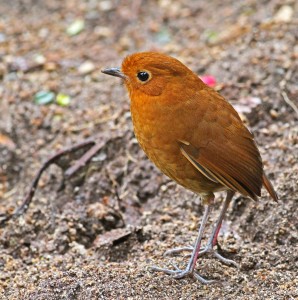Rufous Antpitta Feature

Antpittas are one of those quintessential groups of tropical birds. They may not be colorful, like tanagers, coatings, or manakins, nor are they large and noisy birds that are out in the open and in your face, like toucans or parrots. But there’s just something about them and their weird, nearly tailless bodies on top of stilt like legs, and their way of moving through the dense growth in bounding leaps that makes them irresistible. Add that to the fact they’re rarely seen and they are usually among the most wanted birds on a visit to the southlands.
Because antpittas are shy and rarely seen, their vocalizations tend to get a lot of attention. After all, it’s an exceedingly rare event that you see an antpitta before you hear it! In addition to being a good way to find them, it’s also a good way to learn something about their taxonomy. Since antpittas are suboscines, they don’t learn their songs, and systematic differences in their vocalizations indicates some underlying genetic difference as well. It was vocal variation, in part, that resulted in the recent split of Sucre Antpitta (Grallaricula cumanensis) from Slate-crowned Antpitta (Grallaricula nana; SACC 421). And there are other groups that are just begging to be studied: Tawny Antpittas (Grallaria quitensis) sound different between Colombia, Ecuador, and Peru; Chestnut Antpitta (Grallaria blakei) has a little known and unnamed southern population that sounds different from the more common northern one; Rusty-breasted Antpitta (Grallaricula ferrugineipectus) is already split by many authorities (though not the South American Checklist Committee) into northern and southern forms because of their different songs and calls. And beating them all, Rufous Antpitta has no less than SEVEN vocal types, all very different from the others, that surely represent a number of separate species.
And it’s that species that I’ve just written a Xeno-Canto feature on. Given its exceptional complexity, even for a tropical species group, I also made a map (shown below) of where the various subspecies occur, and added map points for the specific recordings I discuss in the feature. From north to south the (sub)species shown are: spatiator (dark blue), saltuensis (brown, no recordings), unnamed ssp (green), nominate rufula (purple), cajamarcae (yellow), obscura (light blue), and occabambae and cochabambae (red). If you want to read more about Rufous Antpittas and their remarkable vocal variation, follow this link and read on!
View Rufous Antpitta subspecies distribution in a larger map